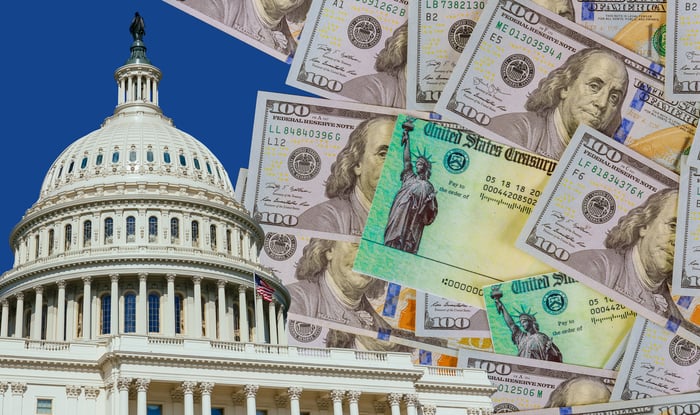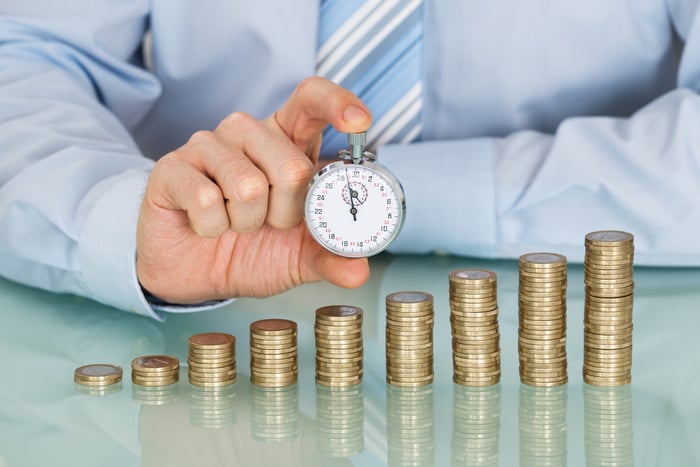For many Americans, relief is on the way, or perhaps has already hit your bank account.
On March 11, President Joe Biden signed a $1.9 trillion coronavirus disease 2019 (COVID-19) stimulus bill into law, pushing the total amount of relief approved by Congress to more than $5 trillion since the pandemic began. Included in this legislation is $350 billion in state, local, and tribal relief, an extension of the $300 a week boost in unemployment payments, and tens of billions in additional funds to support the vaccination, distribution, and COVID-19 research campaign.

Image source: Getty Images.
Should you invest your $1,400 stimulus payout?
However, the star of this $1.9 trillion relief bill is the $1,400 stimulus checks that are being sent to an estimated 159 million Americans. As of March 16, approximately 90 million payouts had already hit bank accounts via direct deposit, with a small number of paper checks issued, as well.
For some recipients, this $1,400 stimulus payment will be used to pay rent or their mortgage, cover utility bills, or perhaps even put food on the table. It's going to take time for the U.S. economy to recover from its worst economic shock in many generations, and many workers have been hurt financially.
But not all stimulus recipients are necessarily worse for the wear. For those folks whose income was unaffected by COVID-19 and who have a healthy emergency fund, a $1,400 payout might be best put to work in the world's greatest wealth creator: the stock market.
In recent weeks, I've offered up ideas on how payment recipients in this latter category could put their $1,400 check to work to generate substantial dividend income or potentially triple their payout with growth stocks. While I believe the ideas I've offered can help stimulus recipients build wealth, it's not a guarantee that the companies I've suggested investing in will head higher.

Image source: Getty Images.
This investment is guaranteed to build your wealth -- with a catch
There are virtually no guarantees when it comes to investing in the stock market, with one exception: An S&P 500 (^GSPC -0.33%) tracking index, such as the SPDR S&P 500 ETF Trust (SPY -0.33%)-- albeit, there's still a catch.
Recently, financial market and economic research company Crestmont Research examined rolling 20-year total returns (i.e., including dividend payments) for the S&P 500 between 1919 and 2020 (a 102-year period). By "rolling," I mean choosing any year between 1919 and 2020 and examining the total return of the 19 years preceding it, as well as the year you've chosen. For instance, examining the 20-year rolling returns for 1965 would involve examining years 1946 through 1965.
Crestmont found that at no point over this 102-year period would an investor's average annual total return have been negative, as long as they held onto their investment in an S&P 500 tracking index for 20 years. That's the catch: Investors need to be patient and hang onto a tracking index, like the SPDR S&P 500 ETF, for a full 20 years. If they do, history has shown they're guaranteed to build wealth.
Here's what even crazier: There were only two instances over this 102-year stretch (1948 and 1949) where the end year of a 20-year rolling period produced an average annual total return below 5%. By comparison, average annual total returns surpassed 10% in more than 40 end years and were at least 13% in 20 end years.

Image source: Getty Images.
Here's why the S&P 500 and its tracking index have proved unstoppable
If you're wondering what secret sauce the S&P 500 is using to deliver such amazing returns, the answer lies with three factors.
To begin with, investor emotions and news-driven events aren't what move markets over the long term. Instead, the companies that make up the S&P 500 rely on operating earnings growth to drive their valuations higher. Sitting back and allowing some of the greatest domestic and multinational businesses to build moats, innovate, and grow their income over time is one reason the S&P 500 has always headed higher over the long run.
Secondly, don't overlook the power of dividend income. Over the trailing 20-year period (through March 22), the benchmark S&P 500 is higher by 252.6%. But tack on dividends, and the S&P 500's return over the same period vaults to 420.1%. That's a huge difference and a big boost to investors' average annual total returns.
Third and finally, understand that the S&P 500 is a dynamic index. Although it's made up of a diverse group of 500 companies, the smallest companies that underperform are being cycled out. Meanwhile, the largest and most successful businesses are becoming a larger percentage of total weighting -- the S&P 500 is a market cap-weighted index. It's only natural for the index to rise over time if the most successful businesses control the lion's share of the S&P 500's weighting.
Long story short, if you want a guaranteed way to build wealth with your $1,400 stimulus check, buy the SPDR S&P 500 ETF and hold on for at least 20 years.





